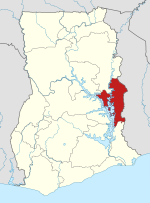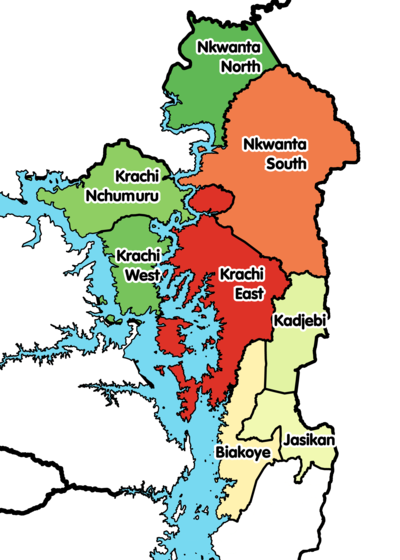Oti Region
 From Wikipedia - Reading time: 9 min
From Wikipedia - Reading time: 9 min
Oti Region | |
|---|---|
 Kyabobo National Park near the border with Togo | |
 Location of Oti Region in Ghana | |
| Country | Ghana |
| Capital | Dambai |
| Districts | 9[1] |
| Government | |
| • Regional Minister | Daniel Machator[2] |
| Population | |
• Total | 742,664[3] |
| Time zone | GMT |
| Area code | 031 |
The Oti Region is one of the six newly created regions of Ghana[4][5] in December 2018.[6][7] The region was carved out of the Volta Region and will be in fulfillment of a campaign promise made by New Patriotic Party. Prior to the 2016 Ghanaian general election, the then candidate Nana Akufo-Addo declared that when elected, he would explore the possibility of creating new regions out of some of the existing regions in Ghana in order to bring government closer to citizens.[8] The Region was inaugurated on May 14, 2019. It has Dambai as its Regional Capital.[7] The people of Oti region have for more than 60 years always wanted to have a region of their own before its creation in 2018 by the President Nana Addo Dankwa Akufo-Addo led government in December 2018.[9]
History
[edit]The execution of plans for the creation of the regions was seeded to the newly created Ministry of Regional Reorganization and Development[10] which is under the leadership of Hon. Dan Botwe. Government of Ghana ministry charged with the responsibility of supervising the creation of new regions in Ghana.[10] In March 2017, the ministry sent the blue print for the creation of the region along with others to the Council of State. The council met over 36 times from the time of submission to August 2017.[11] The final stage for the creation of the region was decided through a referendum by the people within the catchment of the new region.[12] A referendum on 27 December 2018[13] approved the creation of Oti Region. On election day, 323,708 out of 366,481 (88.33% voter turnout) registered voters cast their votes. A total of 319,296 (98.64 per cent) voted Yes and 2,878 voted No (0.89 per cent) while the number of rejected ballots was 951 (0.24 per cent).[14][15][16]
Administrative divisions
[edit]The political administration of the region is through the local government system. Under this administration system, the region is divided into Nine (9) Municipal and District Assemblies (M/DAs) (made up of 4 Municipalities and 5 District Assemblies).[17][18] Each Municipal and District Assembly, is administered by a Chief Executive, representing the central government but deriving authority from an Assembly headed by a presiding member elected from among the members themselves. The current list is as follows:

| # | MMDA Name | Capital | MMDA Type | Chief Executive |
|---|---|---|---|---|
| 1 | Biakoye | Nkonya Ahenkro | District | Hon. Millicent Kabuki Carboo[19] |
| 2 | Jasikan | Jasikan | Municipal | Hon. Elizabeth Kessewah Adjornor[20] |
| 3 | Kadjebi | Kadjebi | District | Hon. Wilson Kwami Agbanyo[21] |
| 4 | Krachi East | Dambai | Municipal | Hon. Bernard Aboakoja Mensah[22] |
| 5 | Krachi Nchumuru | Chinderi | District | Hon. Nkrumah Kwesi Ogyile[23] |
| 6 | Krachi West | Kete Krachi | Municipal | Hon. Emmanuel Kajal Jalula[24] |
| 7 | Nkwanta North | Kpassa | District | Hon. William Nawugma Kidignang[25] |
| 8 | Nkwanta South | Nkwanta | Municipal | Hon. Bright Lenwah[26] |
| 9 | Guan | Likpe-Mate | District | Hon. Janet Emefa Obro-Adibo[27] |
Geography and climate
[edit]Location and size
[edit]The Oti Region is bordered on the north by the Northern region, to the south by the Volta Region, and to the west by the Volta Lake. It has 9 districts.
Climate and vegetation
[edit]The Oti Region is much drier than the rest of the southern areas of Ghana, due to its proximity to the north. The vegetation consist of mostly of grassland, especially savanna with clusters of drought-resistant trees such as baobabs or acacias. Between December and April is the dry season. The wet season is between about May and November with an average annual rainfall of 750 to 1050 mm (30 to 40 inches). The highest temperatures are reached at the end of the dry season, the lowest in December and January. However, the hot Harmattan wind from the Sahara blows frequently between December and the beginning of February. The temperatures can vary between 14 °C (59 °F) at night and 40 °C (104 °F) during the day.
Natural Resource Potential
[edit]The Ghana Geological Survey Authority has discovered large quantities of Iron ore deposits in Akokrowa, a farming community in the Oti Region of Ghana. The iron ore, according to the geological investigation, is 55.22 weight percent (Fe) and of a higher grade. It is anticipated that the exploration and the business of the Iron will create jobs and wealth for the people of Oti and the country in general.[28]
Tourism & Parks
[edit]- Kyabobo National Park:[29] The reserve is situated in Nkwanta, in the Nkwanta South District of the area, between the Savannah and tropical rain forest. The reserve was established in 1993 with the intention of safeguarding wildlife and other endangered animal species while also giving them a comfortable place to live away from danger and human activity. The boundaries of the park have, however, been altered numerous times since then.[29]
- Lake Volta
- Breast Mountain, Chilinga
- Chaiso Forest Reserve
- Hanging Village, Shiare[30]
References
[edit]- ^ "Ghana Statistical Services". statsghana.gov.gh.
- ^ "Reshuffle: See list of ministers sacked by President Akufo-Addo and those replacing them – Graphic Online".
- ^ "Ghana Statistical Services".
- ^ "NCCE urges protection of water bodies – MyJoyOnline.com". MyJoyonline. Retrieved 2021-05-18.
- ^ "Know the 16 regional capitals of Ghana". Graphic Online. Retrieved 2021-06-12.
- ^ Duncan, Jude (28 December 2018). "Referendum: Oti residents okay new region with 99% YES vote". Citi News Room. Retrieved 6 September 2019.
- ^ a b "Oti Region – National Commission on Culture". Retrieved 2023-09-13.
- ^ "Lack of facilities impede healthcare service delivery in Oti – Osei Kufuor Afreh – MyJoyOnline.com". MyJoyonline. Retrieved 2021-05-19.
- ^ "'Creation of Oti Region was to bring governance closer to the people' - Akufo-Addo". GhanaWeb. 2021-01-06. Retrieved 2023-09-13.
- ^ a b "2nd Ministerial list out: Akufo-Addo creates new ministries, re-aligns old". myjoyonline. Archived from the original on 31 July 2017. Retrieved 22 June 2017.
- ^ "Council of State met 36 times on new Regions – Nana Otuo Siriboe II". GhanaCrusader.com – Latest News in Ghana and Beyond. 2017-08-16. Archived from the original on 2017-12-12. Retrieved 2017-12-12.
- ^ ""Creation Of New Region In Your Hands" – President Akufo-Addo To Nayiri – The Presidency, Republic of Ghana". presidency government of ghana. Archived from the original on 2017-12-11. Retrieved 2017-12-12.
- ^ "Referendum: Massive YES votes for 6 new regions | General News 2018-12-28". GhanaWeb. 28 December 2018. Retrieved 2019-01-02.
- ^ "All six proposed regions meet constitutional threshold requirements – EC". Ghana Business News. 29 December 2018.
- ^ Zurek, Kweku. "Confirmed: Results of the 2018 Referendum on new regions". Graphic Online. Retrieved 2019-01-02.
- ^ "Referendum: 6 new regions get massive 'YES' votes". pulse ghana. 2018-12-28. Retrieved 2019-01-02.
- ^ "One District One Factory (1D1F)". 1district1factory. Retrieved 2020-05-27.
- ^ "OTI Region – Local Government Service". Retrieved 2023-09-13.
- ^ "Biakoye District makes progress – DCE". Graphic Online. December 7, 2022. Retrieved September 13, 2023.
- ^ GNA (2021-10-04). "Jasikan Assembly confirms Mrs Adjornor as MCE". Ghana News Agency. Retrieved 2023-09-13.
- ^ GNA (2023-01-17). "Kadjebi DCE asks teachers to help improve standards of education". Ghana News Agency. Retrieved 2023-09-13.
- ^ "Krachi East Municipal Assembly". Retrieved 2023-09-13.
- ^ "Krachi Nchumuru nominee confirmed DCE". October 5, 2021. Retrieved September 13, 2023.
- ^ "Emmanuel Kajal Jalula is new MCE for Krachi West". www.myjoyonline.com. Retrieved 2023-09-13.
- ^ Arthur, Abigail (2021-12-03). "Ghana: DCE Outlines Vision for Nkwanta North". Ghanaian Times. Retrieved 2023-09-13.
- ^ "Nkwanta South Municipal Assembly – Unity and Hardwork for Progress and Development". Retrieved 2023-09-13.
- ^ GTonline (2023-02-10). "Likpe Youth accuse Guan DCE of relocating District Departments". Ghanaian Times. Retrieved 2023-09-13.
- ^ "Ghana's Iron Ore Potential and the New Find In the Oti Region: "We Need To Manage Expectations" – HENRY ANTWI". AMN-News, Accra Mining Network. 15 December 2021. Retrieved 18 April 2022.
- ^ a b Pocu, Kojo (2023-08-18). "Kyabobo National Park – Tourist site in Oti Region". Mr. Pocu Blog. Retrieved 2023-09-13.
- ^ khophi (2021-05-26). ""The Hanging Village" – Shiare". Experience Africa Today. Retrieved 2023-09-13.
 KSF
KSF